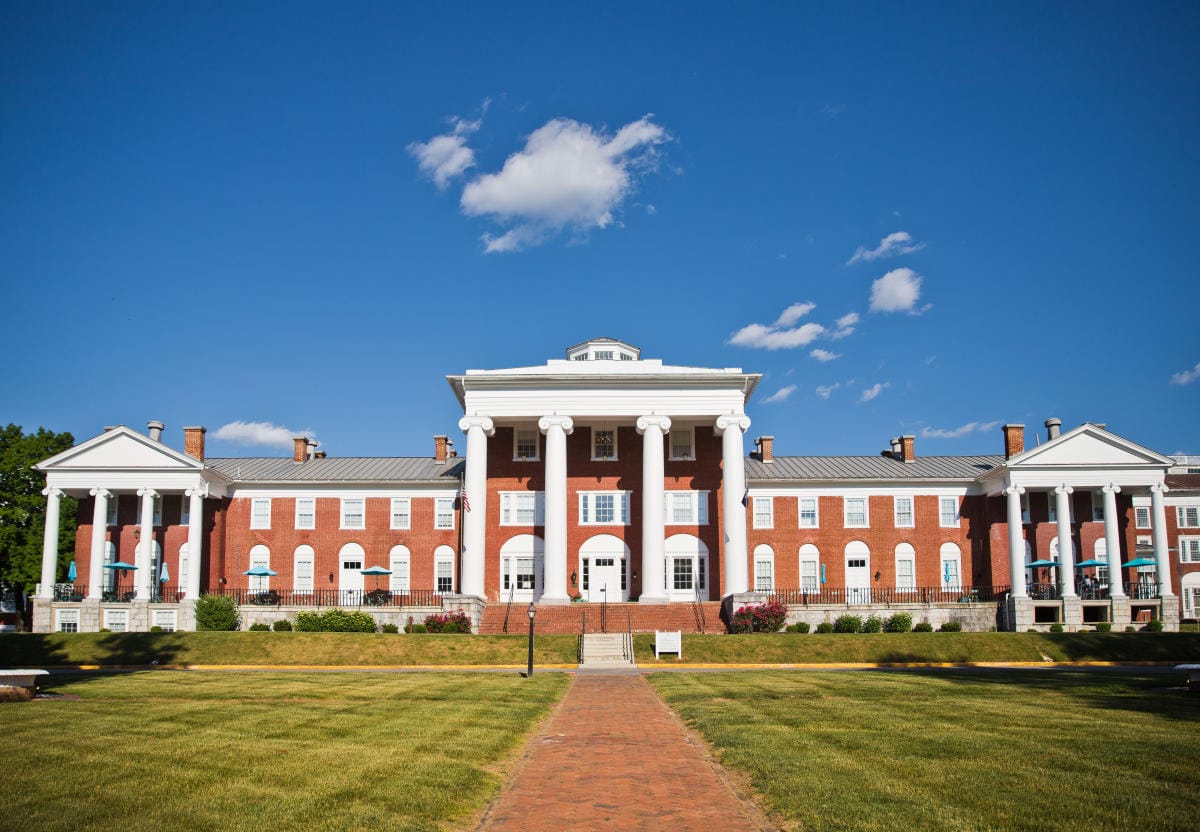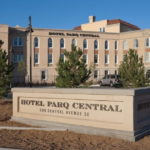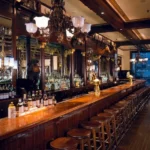Get ready for a historical adventure that’ll make you feel like you’ve stepped back in time! We’re going to explore the Blackburn Inn, a historic gem in Staunton, Virginia. This place is packed with stories, and we’re going to dig deep into its past to learn about its elegant architecture, significant events, and the people who made it a legend. So, grab a seat and let’s embark on a historical journey that will leave you amazed!
History of Blackburn Inn Staunton VA
The Blackburn Inn isn’t just another hotel; it’s a portal to a bygone era. Imagine a grand old building in Staunton, Virginia, where whispers of the past seem to emanate from the very walls. This isn’t mere imagination; this is the legacy of the Blackburn Inn, a place where history is not just preserved but celebrated.
Our journey begins in 1828 when the building first opened its doors, not as a hotel, but as the Western State Hospital. This institution, designed to provide care for individuals with mental illnesses, was the brainchild of Thomas Blackburn, a student of the renowned Thomas Jefferson. Blackburn envisioned a sanctuary bathed in light and fresh air, a stark contrast to the often-grim conditions of asylums at the time. His design, featuring a magnificent rotunda at the heart of the building and expansive wings extending outward, embodied this progressive vision. For over 150 years, the Western State Hospital served as a beacon of hope, offering solace and treatment to countless individuals.
By the dawn of the 21st century, the hospital had closed its doors, leaving behind a grand but silent sentinel to a bygone era. In 2004, two developers, Robin Miller and Dan Gecker, stumbled upon this sleeping giant and recognized its untapped potential. Driven by a desire to honor the building’s legacy while breathing new life into its walls, they embarked on an ambitious 14-year restoration project. Their vision was clear: to meticulously restore the Blackburn Inn to its former glory while seamlessly integrating modern comforts.
Today, the Blackburn Inn stands proudly as a member of Historic Hotels of America, a designation it has held since 2018. Stepping into its grand foyer is akin to entering a time capsule, where the elegance of yesteryears harmonizes with the conveniences of today. But the story doesn’t end there. Researchers and historians are still diligently piecing together the intricate puzzle of the Blackburn Inn’s past, uncovering forgotten stories and shedding light on the lives that graced its halls. Who knows what other captivating secrets await discovery within those historic walls? Perhaps you’ll be the one to unearth them.
When was the Blackburn Inn built?
The Blackburn Inn, while a relatively recent addition to Staunton’s landscape in its current incarnation, occupies a building brimming with history. Before its transformation into a stylish hotel, the structure housed the Western State Hospital, a story that adds a rich layer of intrigue to its present-day charm.
The hospital, designed in 1828 by architect Thomas Blackburn, a student of Thomas Jefferson, marked a departure from the often-dour asylums of the time. Blackburn envisioned a brighter, more humane environment for patients, a vision reflected in his innovative design. Imagine a grand rotunda bathed in natural light, with spacious wings flanking it, promoting air circulation – a revolutionary concept in 19th-century asylum architecture.
For over 150 years, the Western State Hospital served as a cornerstone of the community. Within its walls, countless individuals sought and received care. The dedicated staff continuously sought to redefine psychiatric care, pioneering new treatments and approaches. Their contributions left an indelible mark on the field of mental health, a legacy intertwined with the building’s history.
The year 2004 marked a turning point for the former hospital. It underwent a comprehensive renovation, shedding its former life as a place of healing and emerging as a haven of luxury—the Blackburn Inn. The transformation, however, was not a complete erasure of the past. The renovation was carefully executed, preserving the building’s architectural splendor while infusing it with modern elegance. The result? A 49-room boutique hotel, each room whispering tales of a bygone era.
The Blackburn Inn’s significance extends beyond its aesthetic appeal. It has earned the distinction of being designated a Historic Hotel of America, a testament to the building’s architectural importance and its contribution to Staunton’s vibrant past.
Here’s a snapshot of the Blackburn Inn’s timeline:
| Event | Year |
|---|---|
| Western State Hospital opens its doors | 1828 |
| Hospital designed by Thomas Blackburn | 1828 |
| Western State Hospital operates for 150+ years | N/A |
| Transformation into the Blackburn Inn | 2004 |
| Blackburn Inn designated Historic Hotel | 2018 |
What is the history of the DeJarnette Sanitarium in Staunton, Virginia?
Nestled amidst the serene beauty of the Shenandoah Valley, the DeJarnette Sanitarium stands in stark contrast to its picturesque surroundings. Founded in 1932 by Dr. Joseph DeJarnette, the sanitarium was established with the intent to provide care for individuals with mental illnesses. However, beneath this seemingly benevolent façade lay a darker reality.
Dr. DeJarnette, a prominent figure in the eugenics movement, subscribed to the deeply flawed belief that certain traits were inherently undesirable and hereditary. This dangerous ideology manifested in a horrific practice at the sanitarium – forced sterilization. Countless patients, deemed unfit to reproduce by Dr. DeJarnette, were subjected to these procedures without their consent, leaving behind a legacy of suffering and injustice that continues to cast a shadow over the site.
The winds of change began to sweep through the field of mental health during the 1970s, ushering in a more humane and empathetic approach to treatment. The movement towards deinstitutionalization, advocating for community-based care as an alternative to confinement, gained momentum, ultimately leading to the closure of the DeJarnette Sanitarium.
Today, the sanitarium’s abandoned buildings serve as a chilling reminder of the perils of unchecked medical authority and the devastating consequences of eugenics. Tales of paranormal activity and ghostly encounters have transformed the site into a destination for those seeking a glimpse into a troubled past.
It’s important to note that some historians argue that Dr. DeJarnette’s actions, while undeniably cruel by modern standards, were influenced by the prevailing scientific and societal beliefs of his era. While this context does not excuse the harm inflicted, it underscores the complexities inherent in historical analysis.
Efforts to further understand the sanitarium’s history continue, with ongoing research delving into patient records and testimonies. It is through continued examination and open dialogue that we can strive to learn from this unsettling chapter in Staunton’s past.
The DeJarnette Sanitarium stands as a sobering reminder of the importance of:
- Protecting the vulnerable, especially in matters of medical ethics.
- Acknowledging the lessons embedded within history, even in its darkest chapters.
- Recognizing that our understanding of the past is continually evolving.
Which president lived in Staunton VA?
Staunton’s historical significance extends beyond the grand halls of the Blackburn Inn. This charming Virginia town holds the distinction of being the birthplace and childhood home of the 28th President of the United States, Woodrow Wilson.
Wilson’s boyhood home, located a stone’s throw from the Blackburn Inn, offers a glimpse into his formative years. It’s intriguing to consider that a young Woodrow Wilson may have strolled past the imposing structure that would one day become the Blackburn Inn, unaware of its future transformation and the intertwining of their stories in the annals of history.
What hotel was the Western State Hospital turned into?
Prepare to be amazed! Remember the Western State Hospital, steeped in history and shrouded in tales of a bygone era? Well, that very building has undergone a remarkable metamorphosis, emerging as the Blackburn Inn, a boutique hotel that seamlessly blends history with modern luxury.
Imagine stumbling upon this architectural gem while meandering through the picturesque Shenandoah Valley. Designed by Thomas Blackburn, a student of the renowned Thomas Jefferson, the building exudes a timeless elegance. The influence of Jeffersonian architecture is evident in the clean lines and harmonious proportions, a testament to Blackburn’s lineage and the enduring legacy of American architectural traditions.
Stepping into the Blackburn Inn is akin to traveling back in time. The meticulous restoration has preserved intricate details – from ornate moldings to a grand staircase that commands attention. Each room possesses a distinct character, seemingly imbued with the stories of those who walked its halls in a bygone era.
The significance of the Blackburn Inn extends beyond its aesthetic appeal. By preserving the building’s past, it offers a glimpse into the evolution of mental health care in the United States. It stands as a testament to the struggles and triumphs of the individuals who were cared for within those very walls.
The Blackburn Inn’s transformation is a testament to the power of adaptive reuse – the ability to breathe new life into historic structures while honoring their past. It serves as a shining example of how history, hospitality, and modern comforts can be artfully combined to create an unforgettable experience. Trust me, a sojourn at the Blackburn Inn is a journey through time you won’t soon forget.
What is the history of the Blackburn house?
Let’s rewind the clock and delve deeper into the intriguing past of the Blackburn Inn. This elegant hotel wasn’t always a place for travelers seeking respite and luxury. For a significant portion of its existence – over 150 years to be precise – it served as part of the Western State Hospital, a psychiatric facility that played a vital role in the history of mental health care.
The building itself is a testament to the architectural trends of its time. Constructed in the Greek Revival style, a popular choice in the early 19th century, it features grand columns and a symmetrical design that exudes a sense of timeless elegance. Given that the architect, Thomas Blackburn, was a protégé of the renowned Thomas Jefferson, it’s plausible that Jefferson’s own architectural sensibilities influenced the design.
Fast forward to 2018, a pivotal year in the building’s history. The former hospital underwent a remarkable transformation, emerging as the Blackburn Inn, a chic 49-room boutique hotel. The developers, however, understood the importance of preserving the building’s historical character. They retained the architectural details that made it unique, seamlessly blending old-world charm with modern amenities.
So, when you step into the Blackburn Inn, you’re not merely entering a hotel; you’re stepping back in time. It’s a tangible connection to Staunton’s past, a place where the stories of bygone eras whisper to those who listen.
Intrigued to uncover more? Explore the Blackburn Inn’s website, where they’ve dedicated a section to its rich and layered history. Who knows what other fascinating details await discovery?
When was the town of Blackburn founded?
While the Blackburn Inn’s own story begins in 1828, coinciding with the establishment of the Western State Hospital, pinpointing the exact founding date of the town of Blackburn requires a bit more historical detective work. The Inn’s history is deeply interwoven with that of the town, but a definitive founding date for Blackburn remains elusive.
We can, however, make some educated deductions based on available evidence. The construction of the Blackburn Inn in 1828 suggests that a settlement, if not a formally established town, likely existed in some form. The erection of such a grand structure indicates a population substantial enough to warrant it. Furthermore, towns often sprouted up around key institutions, and the Western State Hospital could have easily served as such a nucleus for Blackburn.
Adding another layer to this historical enigma is Thomas Blackburn himself. While his primary contribution is the Inn’s design, some historians speculate that his influence may have extended to the town’s early development. Architects often played a role in shaping the areas surrounding their projects, and it’s possible that Blackburn’s vision left its mark on the budding town.
To unravel the mystery of Blackburn’s founding, a deep dive into local archives, property records, and old maps is in order. Who knows what treasures await discovery – a forgotten document, a hand-drawn map, a faded signature that unlocks the secret? Perhaps one day, the answer will be revealed, but for now, the founding of Blackburn remains an alluring mystery waiting to be solved.
When was Blackburn station built?
Your curiosity about train stations is intriguing! However, while our journey centers on the captivating history of the Blackburn Inn, a former hospital, determining the precise construction date of a “Blackburn station” requires a bit more context. It’s possible that several places bear this name, each with its own unique story.
Speaking of stories, let’s return to the captivating tale of the Blackburn Inn. Originally known as the Western State Hospital, this grand dame opened her doors in 1828, marking the beginning of nearly two centuries of history etched within her walls. The building’s design, with its stately columns and symmetrical layout, might evoke memories of another architectural icon – the University of Virginia. The resemblance is no coincidence! The hospital embraced the popular Greek Revival style, championed by none other than Thomas Jefferson himself. And who better to carry the torch of this architectural tradition than Thomas Blackburn, a gifted architect who honed his skills under Jefferson’s guidance?
For over 150 years, the Western State Hospital played a vital role in providing mental health care. The prevailing belief at the time was that surrounding patients with beauty could aid in their healing, hence the elegant design. The hospital’s doors finally closed in 1994, marking the end of an era.
But this wasn’t the end for the grand old building. Instead of being left to decay, it was granted a new lease on life. Through a meticulous renovation, it transformed into the Blackburn Inn we know today. The preservation of historical details ensured that the building’s unique character shone through. Now, with its 49 cozy rooms, inviting restaurant, and modern amenities, it has become a beloved destination for travelers and locals alike. Whether it’s a dream wedding or a special celebration, the Blackburn Inn has once again come alive.
While the mystery of “Blackburn station” remains unsolved for now, exploring architectural history and the evolution of places like the Blackburn Inn reminds us that every brick, every beam has a story to tell. Perhaps your “Blackburn station” is out there, waiting for its moment in the spotlight.
What was the Blackburn during WW2?
The Blackburn Inn’s journey through time takes a poignant turn during World War II. During this tumultuous period, the building, then still operating as a regional hospital, took on a new and vital role. Imagine the scene – soldiers injured on distant battlefields finding their way to Staunton, to Blackburn, seeking solace and medical care. The staff, thrust into extraordinary circumstances, rose to the challenge, becoming everyday heroes. Doctors, nurses, volunteers – all united in their mission to mend broken bodies and spirits.
During this time of global conflict, the Blackburn Inn, a place always dedicated to healing, took on a profound significance. It became a beacon of hope, a symbol of resilience for a community touched by the realities of war. One can only imagine the stories whispered within its walls – tales of courage, of loss, of the indomitable human spirit.
Even today, long after the echoes of war have faded, the Blackburn Inn’s legacy from that era endures. It serves as a reminder of the sacrifices made, the lives forever altered, and the unwavering spirit that saw a community through a time of unprecedented challenge.
Reflecting on this chapter in the Blackburn Inn’s story:
- It’s a reminder that the building’s story began not with luxury, but with a deep commitment to serving those in need.
- During World War II, the Blackburn Inn answered the call to duty, providing refuge and healing to wounded soldiers.
- The dedication of the staff and volunteers during that time stands as a testament to the power of compassion and resilience.
- The Blackburn Inn’s wartime service remains an integral part of its identity, shaping its narrative and reminding us of the enduring impact of history.
When was the Blackburn Hamlet bypass built?
It seems we’ve veered slightly off course! While the Blackburn Inn’s history is undeniably captivating, there’s no record of a “Blackburn Hamlet bypass” in its chronicles.
Could it be that you’re thinking of a different Blackburn Hamlet? It’s quite possible that a location with this name exists elsewhere, and information about its bypass might be found through a different avenue of research.
If you can provide more details about the specific “Blackburn Hamlet bypass” you’re interested in, perhaps we can uncover more information together!
When was the Inn at the Presidio built?
While our current exploration centers around the Blackburn Inn’s rich history, your question about the Inn at the Presidio beckons us to journey westward and delve into another fascinating tale of architectural transformation and historical significance.
Nestled within the breathtaking expanse of San Francisco’s Presidio National Park, the Inn at the Presidio isn’t your typical hotel; it’s a living testament to the park’s layered past. Rather than having a single construction date, the Inn’s story unfolds like an intriguing historical novel, marked by periods of adaptation and reinvention. The buildings that now make up the Inn at the Presidio were not always intended for rest and relaxation; they once served as distinguished homes for U.S. Army officers and their families, their foundations laid long before the park’s conception.
A Peek into the Past:
To trace the Inn’s origins, we must venture back to 1895 when the Presidio bustled with military activity. It was during this era that construction began on Pershing Square, a residential complex designed to house the officers stationed there.
From Military Housing to Boutique Retreat:
Fast forward through the decades, past two World Wars and the tense stand-off of the Cold War. The Presidio witnessed a dramatic shift in its role and significance. By 1994, with the military presence waning, a bold vision emerged – transform this historic site into a national park. Instead of demolishing the stately officer residences, a remarkable decision was made to give them a new purpose. Meticulous restoration efforts commenced, preserving their architectural splendor while adapting them for a new era.
The Birth of the Inn at the Presidio:
Finally, in 2012, the Inn at the Presidio opened its doors, inviting guests to experience the unique charm and storied past of these beautifully preserved buildings. Today, a stroll through the Inn’s hallways is akin to a journey through time, surrounded by whispers of the Presidio’s captivating history.
Unveiling the Timeline:
- 1895: Construction of Pershing Square, the future home of the Inn at the Presidio, begins.
- Late 19th – Early 20th Century: Pershing Square serves as housing for U.S. Army officers and their families, witnessing the ebb and flow of military life.
- 1994: The Presidio undergoes a profound transformation, transitioning from a military post to a national park dedicated to preservation and recreation.
- 2012: After extensive restoration, the Inn at the Presidio opens its doors, offering a unique blend of history and hospitality.
The Inn at the Presidio’s story reminds us that history is rarely linear; it’s a tapestry woven with threads of change, adaptation, and the enduring power of preservation.
To learn more about Baskerville and the origins of the typeface that bears his name, explore this comprehensive historical document on the history of Baskerville typeface.
While exploring the South, don’t miss the opportunity to experience the serene beauty of the Bellingrath Gardens, a horticultural masterpiece that has captivated visitors for generations.
- Crypto Quotes’ Red Flags: Avoid Costly Mistakes - June 30, 2025
- Unlock Inspirational Crypto Quotes: Future Predictions - June 30, 2025
- Famous Bitcoin Quotes: A Deep Dive into Crypto’s History - June 30, 2025
















